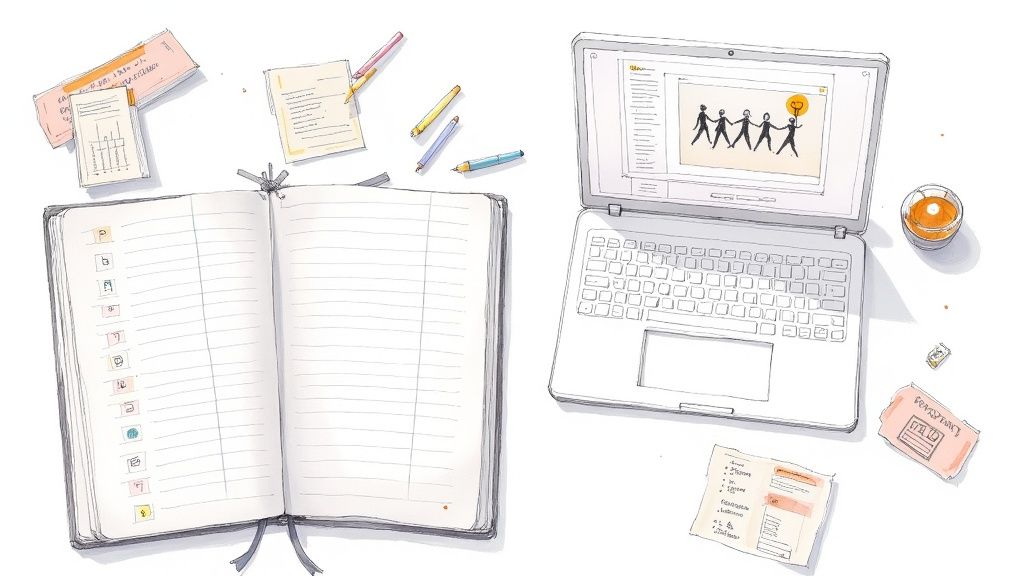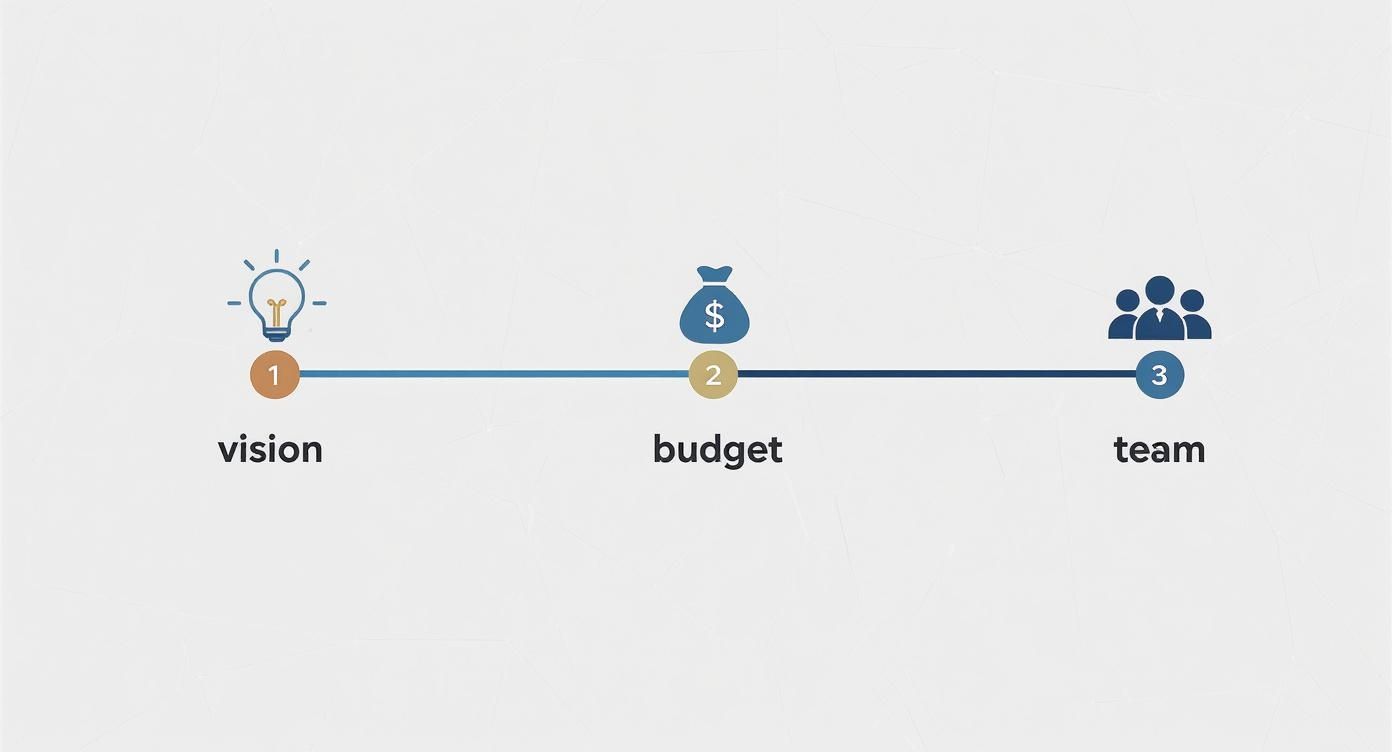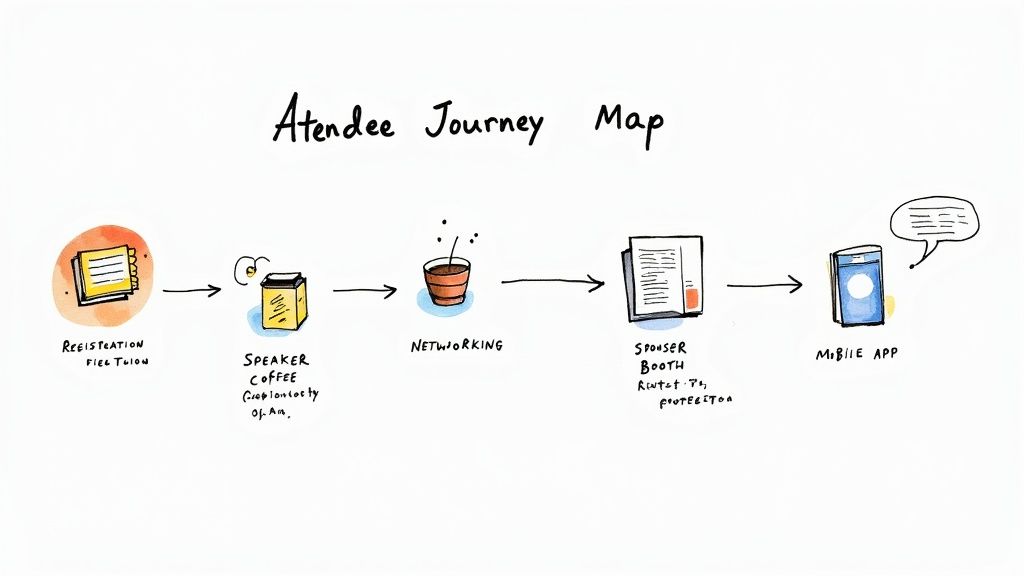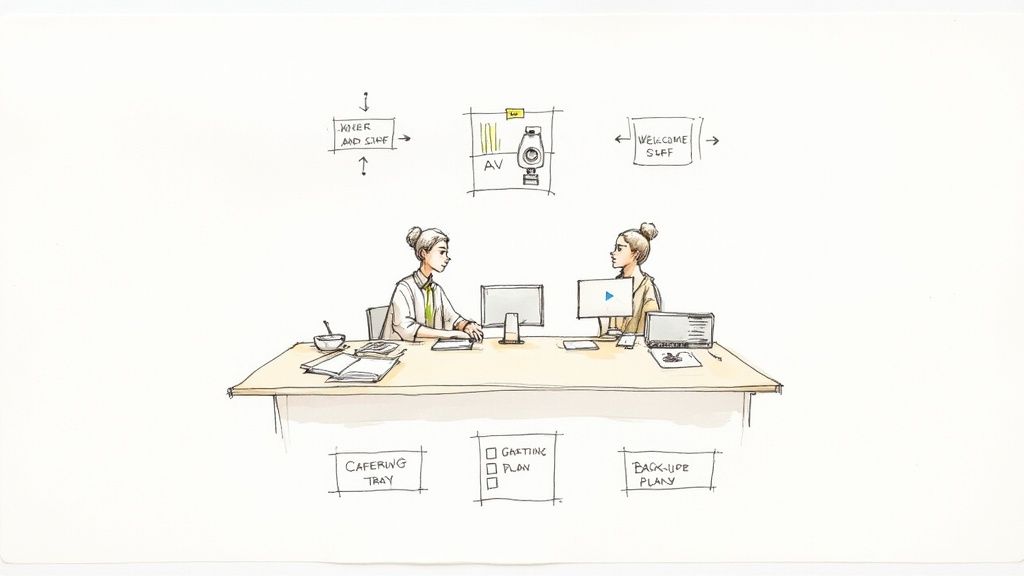November 19, 2025

To kick things off, pinpoint your event’s core purpose, lock in a realistic budget, and bring together a committed team. Those three elements become your north star, steering every decision from venue scouting to promotion. Nail this foundation, and you’ll avoid last-minute scrambles.
Great gatherings don’t happen by accident. You need a clear roadmap that turns a spark of an idea into a smooth-running event. Think of this phase as laying the groundwork—you’ll save time, money, and headaches down the line.
Below is a quick overview of the foundational elements you must nail before diving into the finer logistics.
Essential Event Planning Checklist
A summary of the core foundational elements every event planner must define before moving into detailed logistics.
With these pieces in place, you’ll have a sturdy framework to guide every next step.
Goals are more than buzzwords—they’re your success metrics. Swap vague ambitions like “boost engagement” for precise targets such as 40% member attendance and 200 completed surveys. This level of detail shapes your messaging, speaker line-up, and even the breakout sessions you plan.
Well-defined goals give your team clarity and speak volumes to sponsors. They answer, “What’s in it for me?”
If you need a template to capture every detail, check out this handy event brief format.
Once your goals are clear, it’s time to map your finances and schedule. Break down costs from big-ticket items—venue rental and catering—to smaller fees like insurance and payment processing. Don’t forget a 10–15% contingency for surprises.
At the same time, build a reverse timeline. Start at the event date and work backward, marking milestones like contract sign-offs, marketing launches, and speaker confirmations. This visual plan keeps tasks flowing naturally, cutting out last-minute rushes.
Consider exploring a comprehensive corporate event planning checklist to make sure nothing slips through the cracks.

This graphic breaks down the three pillars—Vision, Budget, Team—and shows how they stack to support your entire project.
Your blueprint only works if you’ve got the right people driving it. Start by naming an event manager to keep everything on track. Then bring on specialists for:
• Marketing & Communications: Crafts your outreach and social media buzz.
• Logistics Coordinator: Juggles vendors, venue details, and on-site AV.
• Sponsorship/Finance Lead: Manages budgets, ticket sales, and sponsor relationships.
Set up a consistent check-in schedule and pick a single platform for updates—Slack, Microsoft Teams, or any tool your crew prefers. That way, everyone stays informed and ready to tackle their tasks without overlap.

Once you've nailed down the fundamentals—your goals, budget, and timeline—it’s time to shift your focus from the "what" to the "who." Your attendees. Every decision you make from here on out should be filtered through the lens of their experience. This is where you elevate a simple gathering into something memorable, creating the kind of value that keeps members and sponsors coming back year after year.
The very first impression they'll have is your registration process. A clunky, confusing sign-up page can lose you an attendee before they even hit "confirm." Your ticketing strategy needs to be simple on the surface but smart underneath, guiding people to commit early and feel good about it.
A great ticketing strategy does more than just sell tickets; it creates momentum. By layering your pricing, you can build a sense of urgency and appeal to different people in your community, which helps ensure a steady stream of sign-ups instead of a frantic last-minute rush.
Here are a few proven models you can mix and match:
Your registration form isn't just a payment portal; it’s your first opportunity to gather intelligence. Ask smart questions—like dietary needs, session interests, or professional goals—to start personalizing the attendee journey right away.
With a platform like GroupOS, you can set up these custom registration forms and automated ticketing tiers in minutes. It handles the price changes for you, freeing you up to focus on getting the word out and making the whole process of planning your event feel much more manageable.
Your sponsors are partners, not just walking billboards. To attract the best ones, you have to think past the generic Gold, Silver, and Bronze packages. What sponsors really want is a clear return on their investment—that means qualified leads and meaningful brand exposure.
Start structuring your packages around tangible outcomes. Instead of just a logo on a banner, offer a sponsored networking lounge, a branded charging station, or the chance to introduce a keynote speaker. These are high-visibility opportunities that create real engagement. A polished and professional visual identity is also key; investing in strong branding for events can make your sponsorship packages far more attractive.
At the end of the day, content is king. A dull agenda with uninspired speakers can sink an otherwise well-planned event. The goal is to build a program that has a natural flow, keeps energy levels high, and delivers real-world insights that tie back to your event's core purpose.
When sourcing speakers, look for people who are not just experts but also fantastic presenters. Don't be afraid to look beyond the usual suspects—sometimes the most impactful sessions come from rising stars or practitioners with unique, in-the-trenches case studies.
Keep things fresh by mixing up your session formats:
By getting these core elements right—registration, sponsorship, and programming—you're not just planning an event; you're architecting an experience. Every detail contributes to something that feels intentional and valuable, ensuring your attendees are already blocking out their calendars for next year.

Even a standout speaker lineup can’t fill seats if nobody knows—or cares—about your event. That’s when a carefully crafted, multi-channel marketing plan becomes essential. It’s not enough to announce; you need to weave a story that keeps your audience hooked from day one right through to the final call-to-action.
The trick is to spark genuine curiosity early and then feed it. Think of your promotional calendar as a drumbeat: each touchpoint should build momentum until registrations surge.
Before firing up your email platform or scheduling social posts, nail down your event’s single most compelling promise. What problem are you solving? Who will walk away better equipped than before? That promise is your north star—anchoring every headline, graphic, and tweet.
Focus on benefits instead of bullet points. Rather than “Attend our annual summit,” try “Walk away with a blueprint for industry-leading growth.” Clear, bold claims make people stop scrolling.
At the same time, establish a visual fingerprint:
These elements signal professionalism and stick in the mind as you appear across websites, social feeds, and printed materials.
Putting all your eggs in one channel is risky. Instead, layer touchpoints so your message shows up again and again—in different formats and on different platforms. A diversified approach pays off.
Meanwhile, when you’re mapping out ticket tiers and payment flows, keep an eye on effective event ticketing management. Minimizing chargebacks protects your revenue and your reputation.
Your biggest advocates already live in your network: passionate members, past attendees, sponsors. Give them the tools to spread your message authentically.
Create a shareable “promo kit” with ready-made social posts, eye-catching graphics, and a direct registration link. When someone else promotes your event, it carries more weight than any ad.
You can also roll out a simple referral program:
This approach turns your community into a volunteer sales force, multiplying your reach and planting seeds of social proof well before the doors open.
The doors are about to open. After all those months of careful planning, this is the moment your blueprint comes to life. Managing the day-of logistics is all about orchestrating the controlled chaos of a live event, making sure every single touchpoint feels seamless for your attendees.
This isn't just about ticking boxes on a schedule. It’s about anticipating what people need before they even know they need it. A smooth operation is what elevates a good plan into a truly memorable experience.
Your check-in process is your event's first impression, and you only get one shot. Think of it as your welcome mat—it needs to be efficient, friendly, and completely stress-free. A long, confusing line can zap the energy out of a room before the first session even starts.
Here's how to get it right:
For a deep dive into all the little details, our event coordinator checklist template can be a real lifesaver for getting your team organized.
Perfect execution hinges on crystal-clear communication with your technical crew and vendors. Your AV technicians are your partners in making your speakers look and sound great. You absolutely have to schedule a pre-event tech check with every single presenter to test mics, clickers, and slide decks. This simple run-through prevents those awkward delays that kill the momentum of a session.
The same goes for your caterer. Confirm the final headcount, meal service times, and the plan for handling dietary restrictions at least 24 hours out. Trust me, nothing throws off an event's flow faster than a late lunch. The goal is to make all these behind-the-scenes gears turn invisibly.
An experienced event planner knows that the most important conversations happen before the event begins. A 15-minute sync with your AV, catering, and venue leads on the morning of the event can prevent hours of headaches later.
To keep all these moving parts straight, a structured checklist is your best friend. It ensures that every critical task, from pre-event setup to post-event breakdown, is assigned and tracked.
Here’s a sample checklist you can adapt to organize your day-of responsibilities. This framework helps you delegate tasks and provides a clear overview of what needs to happen and when.
Having a centralized document like this empowers your team and gives you, the planner, the peace of mind to focus on managing the overall experience rather than getting stuck in the weeds.
Event planning isn't just about what happens within four walls anymore. Today, 74.5% of organizers are running hybrid events, according to Eventify, mixing live and virtual components to meet the demand for flexibility. While in-person events still drive about 60% of industry revenue, the landscape has permanently shifted.
This means your day-of logistics now serve two distinct audiences. You need to ensure your virtual platform is rock-solid, with a dedicated tech moderator ready to help online attendees. At the same time, the in-person experience has to be magnetic, with easy navigation and engaging moments that make the trip worthwhile.
The real challenge is creating one cohesive event where neither audience feels like they're getting a lesser experience. When you nail the onsite logistics for both your physical and digital attendees, you're not just running an event—you're creating an inclusive, high-value experience that connects your community, no matter where they are.

The closing remarks have been made, the lights are down, and the venue is finally quiet. It’s easy to breathe a sigh of relief and think the job is done. But honestly, the work of turning a great event into a lasting success is just getting started.
This post-event window is your golden opportunity. It’s where you solidify the connections made, prove the event's value, and lay the groundwork for next year. Treating the end of the event as the finish line is a rookie mistake; it’s really the starting line for nurturing the excitement you just built.
Before everyone’s memory of the event gets hazy, you need to capture their honest feedback. Don’t wait on this. The best time to send out your post-event survey is within 24 hours.
Keep your survey short, focused, and mobile-friendly. A high response rate depends on it. Most importantly, ask questions that actually help you measure success against the goals you set way back in the planning phase.
Instead of a generic "Did you enjoy the event?", get specific:
This is the kind of data you can actually use. It shows you exactly what hit the mark and where you have room to improve. Using a platform like GroupOS can be a huge help here, letting you automate the survey sends and then view the results right alongside your registration and engagement numbers.
A post-event debrief is non-negotiable. By looking at what worked (and what didn't), you're not just closing out this event—you're getting a head start on planning the next one. Every event has lessons to teach; applying them is how you avoid making the same mistakes twice.
Think about all the incredible content your event just produced—keynotes, panel discussions, expert insights. Letting it all vanish would be a massive waste. Repurposing this content keeps the conversation alive and delivers value long after the event ends, especially for those who couldn't make it.
The first step is creating a central hub for all your post-event resources. This could be a password-protected page on your website or a dedicated space within your online community.
Here’s what you should be sharing:
This strategy does more than just add value for attendees. It creates a serious case of FOMO (fear of missing out) for anyone who skipped out, which makes marketing your next event a whole lot easier.
The days immediately following your event are a critical time for relationship building. A generic, mass "thank you" email is fine, but it’s also instantly forgettable. A little personalization is what makes your stakeholders—attendees, speakers, and sponsors—feel truly valued.
Think about segmenting your follow-up messages. Each group played a different role, and your communication should reflect that.
This kind of thoughtful follow-up shows you see them as partners, not just transactions. It’s how a one-time sponsor becomes a long-term champion and a first-time attendee becomes a dedicated member of your community. This is the final, essential step in planning an event that truly makes an impact.
Let's be honest, no event goes exactly as planned. The real skill of a seasoned event pro isn't just in the planning, but in how you handle the curveballs. From last-minute budget cuts to a keynote speaker dropping out, having a game plan ready is what separates a minor hiccup from a full-blown catastrophe.
Think of these pointers as your emergency playbook. With a little foresight, you can navigate budget crises, speaker snafus, and tough questions about ROI without breaking a sweat.
It’s the call every event manager dreads: "We need to cut the budget." When sponsor funding shrinks or revenue projections fall short, your first instinct might be to panic. Don't. Swift, strategic action is the key to preserving the quality of your event.
Your immediate focus should be on protecting the core deliverables—the absolute must-haves. This usually means the venue, essential AV, and your keynote experience. Everything else, from the branded swag to the premium lunch options, goes under the microscope.
I once worked with a production manager who had his budget cut by 12% just two weeks before a major conference. Instead of making broad, sweeping cuts, he got surgical. He reallocated funds from a broad digital ad campaign to more targeted on-site signage and got on the phone with his suppliers to negotiate more flexible payment dates. Those moves saved $4,000 without a single attendee noticing a difference.
Cutting costs isn’t about slashing everything. It’s about a strategic shift that protects the high-impact areas your attendees will remember.
When you're facing a cut, get your team in a room—finance, marketing, operations—and map out your critical spending.
Here’s how to start:
Once you’ve made adjustments, communicate them to your attendees and sponsors. A brief, transparent email explaining the smart enhancements you’ve made can go a long way. By highlighting the great things you've kept, like dedicated networking lounges or popular workshop tracks, you maintain trust and show you're still delivering value.
This is a headline-making headache, but it doesn't have to be a disaster. The best way to handle a speaker cancellation is to have planned for it long before it happens. Always, always have a roster of standby speakers.
Having one or two vetted backups who understand they are on your "short list" is a lifesaver.
Your Last-Minute Fill-In Checklist:
A community manager I know lost her main presenter 48 hours before showtime. She pivoted beautifully. She pulled together a panel featuring two past speakers (who were already attending) and a sponsor who could do a compelling tech demo. The session was a huge hit, with attendees rating it 4.7/5 for engagement.
Flexibility can turn a crisis into an unexpected highlight for your attendees.
As soon as a replacement is confirmed, update your event agenda, website, and social channels immediately. Don't just announce the change; promote the new speaker’s expertise with a quick bio and a bulleted list of what attendees will learn. This helps reset expectations and can even fuel a few late registrations.
Ticket sales only tell a fraction of the story. The real return on investment for any professional or community event comes from engagement, connections, and long-term relationships. To prove your event's value, you need to look beyond revenue and dig into metrics that show you've built a stronger community.
Think about surveys, networking analytics, and qualified sponsorship leads to get a full picture of your success.
Key Metrics to Track for Real ROI:
True ROI isn’t one number. It’s the story you tell by connecting data points from ticketing, engagement, and post-event actions.
In a real-world example, a professional association used GroupOS to link their registration data directly with post-event survey scores. Within two weeks, they clearly identified their most popular session, which gave them the proof they needed to secure 3 new sponsors for the following year based on that session's success alone.
And don't forget the qualitative feedback. The conversations happening in networking chats, private group discussions, or post-event Slack channels are pure gold. Track the sentiment in those conversations and use those anecdotes alongside your hard numbers to paint a complete picture of an event that truly delivered.
For an all-in-one platform that helps you tackle budget shifts, speaker changes, and ROI tracking, try GroupOS.


